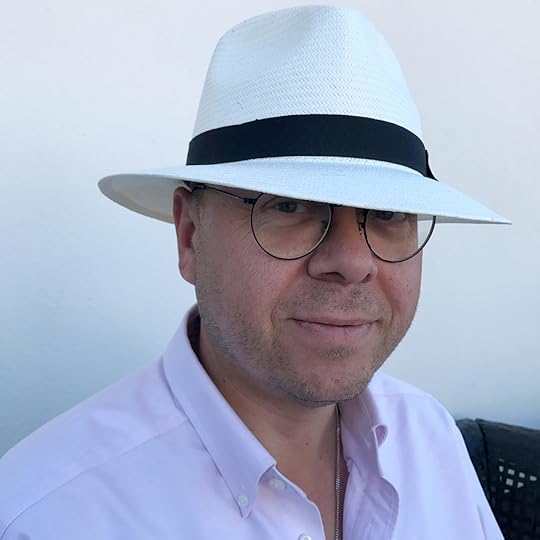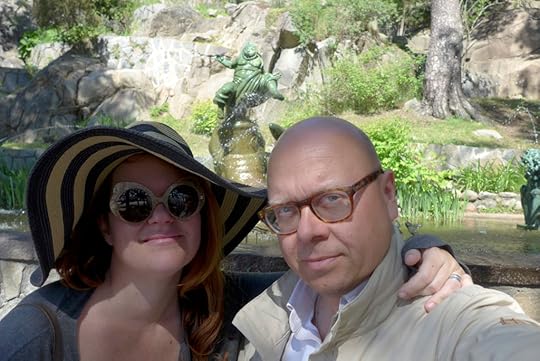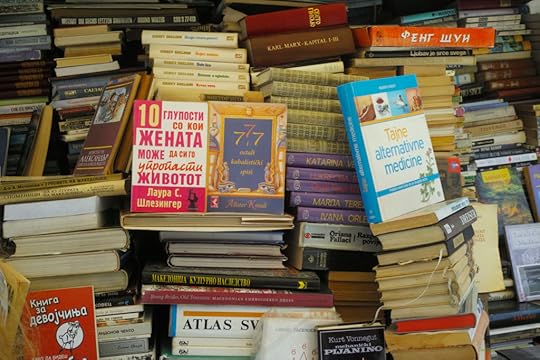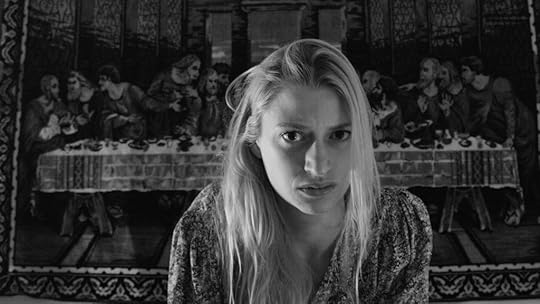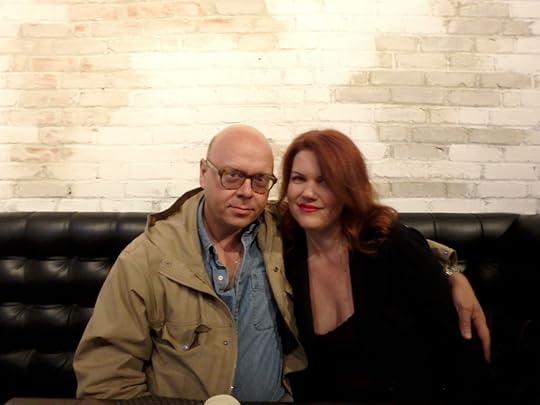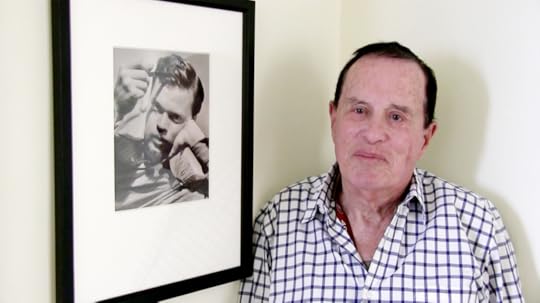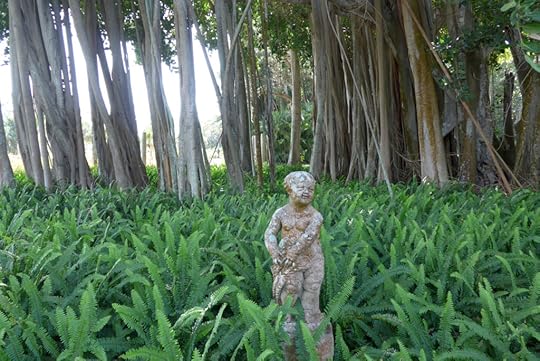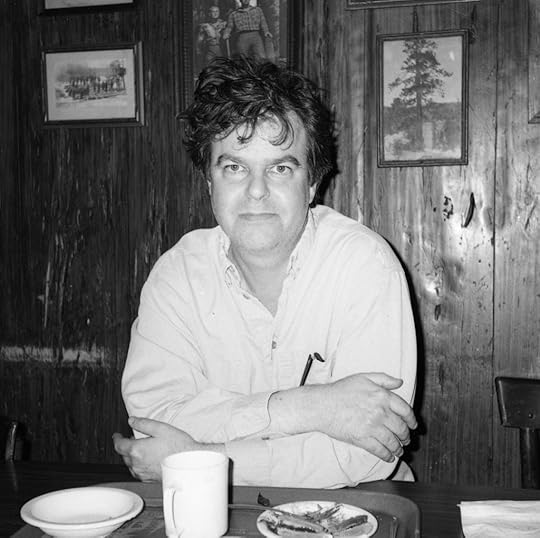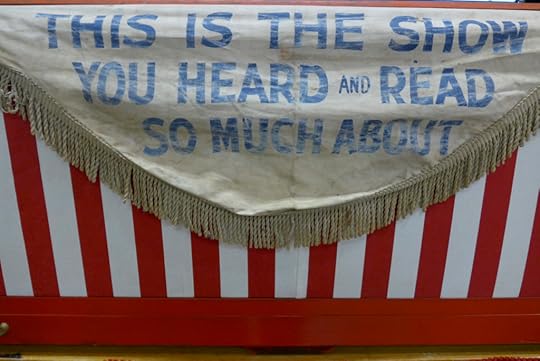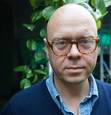Carl Abrahamsson's Blog, page 53
June 2, 2018
In conversation with Radio Church of Mabus
I was recently on the Church of Mabus Radio, in conversation with Jeffery Pritchett and Wham about all things Occulture. A nice conversation although it took place my 2-4 am!
Carl Abrahamsson: Occulture: The Unseen Forces That Drive Culture Forward
May 31, 2018
In conversation with Jim Harold
I was recently interviewed on Jim Harold’s Paranormal Podcast about Occulture – The unseen forces that drive culture forward, and you can listen to it right here:
http://content.blubrry.com/paranormalplus/Occulture-The_Other_Side_190.mp3
(Photo by Vanessa Sinclair)
Patreon + Trapart discount = Happiness!
Beginning from Monday June 4th and for one full week our Patreon supporters receive a 25% discount on everything at the Trapart web site. That’s everything on the site!
And this goes for all levels of Patreon support. Which means one hell of a good deal!
Sign up today and stay tuned on Monday. Thank you!
May 29, 2018
By the power of osmosis…
We all know how inspired we can be by certain people; even at a distance, and even beyond the machinations of time. Several deceased people continue to inspire me. And even living people who you might not know… yet. They can work just fine at a distance but also in close proximity if that scenario should unfold.
Then usually comes the dividing line: communication. As long as my projections are one-sided I can decide as a sovereign that he or she inspires me. And that’s that. But what happens if the person in question talks back?
Well, of course it could be a paradise of resonance and understanding, and new friendships might bloom. But it could also be a situation in which you might for the rest of your life regret that you ever struck up that conversation.
Sometimes the power of osmosis is a greater source of inspiration than a real two-way exchange. This is of course also valid for other essential “agents” of life, such as books. Certain books work wonderfully well as mere benevolent beacons on the shelves. But when you read them they can be major disappointments to such a degree that depression sets in and you might think heretical thoughts (such as getting rid of the tome in question in violent ways).
No matter what, osmosis is a real thing. When we are surrounded by books in some kind of library, we are exposed to the totality of not only the thoughts expressed in them but also of the minds of all those who wrote them.
We don’t necessarily have to read each book to fully integrate it. We can know to a greater or lesser degree what it’s about and how it’s written. Each book is a seed in culture’s soil, and that culture can be studied as a whole from a bird’s eye view or, preferably, sitting still in a library.
What we then choose to actually take in our hands and read will be a life changing experience (as each reading of each book is). It’s like food that isn’t processed, digested and turned to faeces. The book stays with us in our intellectual metabolisms, now and forever.
From a magical perspective, library building carries great potential. The shelves aren’t merely causal containers of already read material but can also to a great degree contain the desired. Meaning literally/literarily books we desire to read. The desired can also be more ephemeral or intangible, and dealing with things beyond the book in question. The book might perhaps never be read “as is”/in itself but rather serve as a transmitter of other kinds of energy; signifying its distinct quality as a spatio-temporal transcendent, and as a reflective surface of your own vanity/strategy. Or all of the above.
Everything we have in our proximity (that also goes for “everyone”) affects us, for good or bad. There are great wisdoms to learn from “intellectual feng shui” (such as re-arranging the books). For instance, what happens when a perfect alphabetisation is disrupted by one single erroneous placement? By several? Or when there’s a mix between the alphabetised and the thematic? Have you ever tried a totally chaotic, random order? (Proceed with caution!)
The energy beamed out from the bookshelves is massive as it is. And it’s yours to use as you see fit. If you’re aware of its rays of influence and inspiration, you can also use the library as a very pure and potent temple space. Not just for meditations and acquiring knowledge but more concretely to restructure yourself as a reflective mosaic of many different wisdoms and directions, all eternally and quaquaversally focused via the prism that is your mind.
May 27, 2018
I woke up with a new film
Sometimes it feels relevant to ask where ideas and creative concepts come from. Although it’s likely that we’ll never truly find out beyond phantasmagorical speculations, sometimes it’s just so mind-blowing to be part of it that we can only believe there is “something” there. And that can be quite enough.
I ascribe to no external theory of some “angel” or “daimon” helping humans out in need or in pleasure. I believe in the human soul making itself heard and seen through the complex machinations of the psyche. In that sense, a schematic image of an idea “bubbling up” or “trickling down” can be useful when talking about it. But I’m not sure it has any value beyond the function of a model.
Anyway, this morning I woke up with a new movie on and in my mind. Bam! From beginning to end, more or less complete. I was amazed. Was it a dream? A hypnopompic revelation? Or a mix? I’m not entirely sure, but there it was nonetheless.
The film in question is a follow-up to my first feature film: “Silent Lips” (Trapart Film 2016). Although I wanted to make a sequel much, much sooner, circumstances simply wouldn’t seem to let me. It was weird. And whenever I fantasised about making the film and jotted down notes about the story, it felt forced and too intellectual-mental.
Three years have now passed since we shot “Silent Lips.” And now it seems that at least the story has been presented for the sequel (tentatively entitled “Silent Tears”), without any major conscious work on my side. That manifestation means I have to take it seriously enough to work with it.
I will let you know how this unfolds, of course. My experience is that I couldn’t not make this movie – even if I tried.
For now, here’s the old “Silent Lips” story:
Young Swedish woman Alice (played by Linn Sparrenborg) travels with her abusive American boyfriend in the Balkans. As their relationship goes from bad to worse, Alice drifts more and more into an emotional void, which leads to violent repercussions. Lost in a strange land among bizarre characters she’s forced to confront aspects of herself she’s utterly afraid of. As abuse and humiliations increase she no longer has a choice. Who will be the next victim? Alice herself or all of those who have ruthlessly exploited her?
Please find enclosed links to the trailers for “Silent Lips”:
Here’s a link to “Silent Lips” proper:
https://vimeo.com/ondemand/silentlips
If you prefer to watch it on DVD, you can get that here:
https://store.trapart.net/home/24-silent-lips.html
[This post was originally posted on Vanessa & Carl’s Patreon . Join us there for more news and updates unavailable elsewhere!]
May 21, 2018
Patreon is a great way to show support
After some months of trying Patreon out, we have found it to be a great platform. We create so many things at such a frantic pace, and to feel that there are people out there willing support us with more than a Thumbs Up actually makes a great difference. That’s why we intend to post more unique Vanessa & Carl stuff at Patreon too, and have different treats for different levels of commitment. Unique videos, musical mixes, photos, cut-ups, collages, and behind the scenes video clips, to mention but a few things. Plus general news before anyone else gets it, of course. To be our patron is to be our friend!
Take a look at what’s there and see if it appeals to you:
Here’s how we’ve segmented the support:
$2 or more per month: Thank you for supporting our work! At this level, you gain access to locked posts and videos, etc. You’re welcome to submit writing to be integrated into the cut-ups, and we can talk about the process more at length. We’re open to questions and comments, so please feel free to post on the Community page! You’ll be able to access us more directly there. And you have our infinite thanks! We truly appreciate it!
$5 or more per month: At this level you’ll be the FIRST to know about any upcoming releases, events, limited editions, etc. You’ll gain access to locked posts and videos. We’re open to questions and comments, so please feel free to post on the Community page! You’ll be able to access us more directly there. And you have our infinite thanks!
$10 or more per month: At this level you’ll get behind the scenes, snapshots, special access to our process, and sneak peaks at works in progress. You’ll be the FIRST to know about any upcoming releases, events, webinars, limited editions, etc. You’ll gain access to locked posts and videos. We’re open to questions and comments, so please feel free to post on the Community page! You’ll be able to access us more directly there. And again you’ll have our infinite thanks!
$23 or more per month: At this level you’ll receive FREE access to Carl’s upcoming webinars. You’ll get behind the scenes, snapshots, special access to our process, as well as sneak peaks at works in progress. You’ll be the FIRST to know about any upcoming releases, events, webinars, limited editions, etc. You’ll gain access to locked posts and videos. We’re open to questions and comments, so please feel free to post on the Community page! You’ll be able to access us more directly there. And of course you’ll have our infinite thanks!
$50 or more per month: At this level you’ll receive our latest book or LP, autographed with a photo and personal thank you note! You’ll be able to attend all of Carl’s upcoming webinars for FREE, and will have access to past lectures, films, and videos online. And you’ll receive a few surprises throughout the year! You’ll get behind the scenes, snapshots, special access to our process, as well as sneak peaks at works in progress. You’ll be the FIRST to know about any upcoming releases, events, limited editions, etc. You’ll gain access to locked posts and videos. We’re open to questions and comments, so please feel free to post on the Community page! You’ll be able to access us more directly there. And you’ll have our infinite thanks!
$100 or more per month: At this level you’ll receive our latest book or LP, autographed with a photo and personal thank you note! AND EACH MONTH you’ll receive an ORIGINAL cut-up created just for you or a special surprise in the mail! PLUS you’ll receive 10% off when you shop at Trapart.net. You’ll be able to attend Carl’s upcoming webinars for FREE and will have access to past lectures, videos, and films online. You’ll get behind the scenes, snapshots, special access to our process, as well as sneak peaks at works in progress. You’ll be the FIRST to know about any upcoming releases, events, and limited editions, etc. You’ll gain access to locked posts and videos. We’re open to questions and comments, so please feel free to post on the Community page! You’ll be able to access us more directly there. And you’ll have our infinite thanks!
$150 or more per month: At this level you’ll receive a care package from us each month. This could include our latest book or LP, autographed with a photo and personal thank you note, DVDs, ORIGINAL cut-up collages, or limited edition items. You’ll receive surprise gifts from us EACH MONTH! Plus you’ll receive 15% off when you shop at Trapart.net. You’ll be able to attend Carl’s upcoming webinars for FREE and will have access to past lectures, videos, and films online. You’ll get behind the scenes, snapshots, special access to our process, as well as sneak peaks at works in progress. You’ll have access to all our locked blog posts, videos, etc and will be the FIRST to know about any upcoming releases, events, and limited editions. We’re open to questions and comments, so please feel free to post on the Community page! You’ll be able to access us more directly there. And you have our infinite thanks!
$230 or more per month: At this level we’ll sit down and have a conversation about what you’d like to receive for your generous patronage. Perhaps you’d like to collaborate in some way, or have new ideas about a direction you’d like to see us go! We’ll create elaborate care packages for you EACH MONTH, which may include books, LPs, DVDs, photographs, personal notes, ORIGINAL cut-up collages, hard to find limited editions or vintage items. Plus you’ll receive 20% off when you shop at Trapart.net. You’ll be able to attend Carl’s webinars for FREE and have access to past lectures, videos, and films online. You’ll get behind the scenes, snapshots, special access to our process, as well as sneak peaks at works in progress. You’ll have access to all our locked blog posts, videos, etc and will be the FIRST to know about any upcoming releases, events, and limited editions. We’re open to questions and comments, so please feel free to post on the Community page! You’ll be able to access us more directly there. You’ll have our infinite thanks! And if we find ourselves in the same city, we should have dinner and drinks!
An Art Apart leads into the future
I’ve been getting some e-mails recently about the An Art Apart documentary series. Basically, “Hey Carl! What happened?” As many of you know, I shot some thirteen documentaries over a period of two years for the An Art Apart series but only finished five. You can check these films out here:
Giving a baby a chainsaw (The Hafler Trio/Andrew McKenzie)
Nothing can turn into a void (People Like Us/Vicki Bennett)
Once the toothpaste is out of the tube (Charles Gatewood)
Change itself (Genesis Breyer P-Orridge)
The mystery of life (Gustaf Broms)
Then I ran out of steam (read: money) and I decided to turn it all into a book instead. To read the full story of that shift, please go HERE.
But of course I still have that funky footage of all the unfinished films. And of course I want to somehow proceed in that magical medium too.
I’m currently thinking of making a joint An Art Apart documentary when the book comes out, to complement and promote the book rather than compete with it. That is, one film that contains shorter sections on all these wonderful artists. Or… Should I somehow carry on with new funding (if I can find it) and make each project/person a film of its own?
Here are the artists that have been filmed but not used so far: Kenneth Anger, Mark McCloud, John Duncan, Carl Michael von Hausswolff, Gea Philes, Angela Edwards, MV Carbon, and Michael Gira.
(For the book project specifically, I have also continued with J.G. Thirlwell, Joe Coleman, Lydia Lunch and Little Annie Bandez.)
I’d be happy to hear from you if you have any good suggestions in terms of film production and funding. And, yes, thoughts on screenings of the already finished films in general too. Everything helps!
Please check out the Trapart Film site if you’re interested and see what kind of ideas pop up in your mind. Thanks!
May 12, 2018
A Garden of Books (for Adam Parfrey)
Now that it’s almost summer time again, the greenery is literally the scenery. I have been blessed with a terrace, and that terrace is filled with trees, bushes, flowers and just an assortment of Chi-enducing beings. The greenery surrounds me and my wife, and we spend as much time as possible in that surrounding. It is in many ways our equivalent to a garden or an oasis.
On the inside, my wife has just finished alphabetising our bookshelves. Not an easy task! Where it used to be all my “intuitive” order (meaning more chaos than order, albeit one in which only I could find my way), now every book in our collection is meticulously and lovingly put in its proper place.
The result of both these processes is a feeling of absolute well-being and harmony; safety even. You need to go no further than to Cicero, who already in the first century BC eloquently stated that all you basically need in life is a garden and a library: “Si hortum in bibliotheca habes, deerit nihil”.
However, Cicero has been misquoted throughout the millennia and I just did it again. What he wrote literally translates as “If you have a garden in your library, nothing will fail.” Yes, please note: “a garden in your library,” not “a garden and a library.” The magical merging of these concepts show that Cicero had a creative and very pagan mind. Why? Because these phenomena are both essentially the same: beautiful extensions of a deeper world soul (Anima Mundi) that permeates both our outer and inner natures.
Each book is a plant; a unique phenomenon and expression. Each plant, ditto a book. Each plant gives off seed that will eventually become something “same but different,” as will each book. It’s a cultivation process that no amount of concrete, asphalt or tyranny can ever stop. The will to live is simply too strong to be contained or circumsized in any way.
A garden and a library then might seem like paradoxical phenomena. If the force itself can’t be contained or controlled, then why even bother applying things like personal aesthetics or shelf order? Isn’t it all just pure vanity?
The reason why we should always strive for this possible paradox is simple: life-affirming alignment. If we are outside of nature and outside of the library we can only apply mental or intellectual filters – at most. Nature can then seem to be “conceptual,” as in chaotic, violent, brutal, beautiful, serene, etc. It’s the same with the library. You think it’s either good (“I get inspired by an accumulation of human knowledge and wisdom”) or bad (“Why bother reading when you can do things instead? There are too many books. The Internet is smarter,” etc.).
But when you’re on the inside looking out (or further in) it’s a completely different story. You realise that life force, Chi, is a very real thing, just like the oxygen the plants provide. In the library, you can of course pick any book and let it provide you with its intellectual-emotional-moral Chi. You can also just stay in the middle of it and let it affect you by osmosis (a very real and tangible phenomenon). Or indulge in any combination.
The human desire to create her own order may not be just a causally brutal way of organising the outer in order to subjugate it, but rather an attempt to subjugate herself in order to fully be able to take in the life-affirming aspects of both these cultures otherwise so overwhelming.
If we are faced with mortal dangers in the jungle or have no water in the desert, the life-affirming and aesthetic aspects of a systemic perfection become pretty null and void. If we are faced with books-as-information/data online or look inside a humongous and soulless chain bookstore that doesn’t appeal to us, the life affirming and potentially inspiring aspects of systemic perfection also become null and void.
We need to cultivate our garden, as Voltaire so correctly stated, and that both in the organic and intellectual sense, as Cicero also so correctly stated. Only then can we be fully immersed in an optimal arena of life enhancement and affirmation.
It doesn’t take a lot either. There can be a library of just one book, just as well as there can be a garden of just one plant. What matters is the degree to which we let it speak to us (and it will if you only listen closely). A very interesting dialogue may ensue.
An addition of just one more plant and one more book, and you’re on your way to timelessly teaming up with the finest human endeavour there is: cultivation. Not in order to subjugate and exploit the outer, but in order to refine and elevate yourself during your own brief lifetime in this magnificent system of endless gardens of books and libraries of plants.
(This text is for Adam Parfrey, 1957-2018)
May 3, 2018
Bits and bobs of dilly dally chit chat
Now that my most recent book Occulture – The unseen forces that drive culture forward is out and available via all the usual suspects, I realise that I can’t regurgitate chapters from that book in my recorded talks and lectures any longer. I have a few more finished recordings that will be posted online: ”Splendor Solis – Lebensreform and sexual vitalism in Germany” and ”What remains for the future? An attempt at a comparison between Aleister Crowley and Rudolf Steiner.” But after this it’ll be all new stuff!
Which brings me to the following experimental question… ”Is there something you’d like to hear me talk about?” I recently finished a piece on psychedelics and witchcraft that will be recorded and posted soon. But… what should follow after that? Now’s the time to step up and demand the (im)possible! What strangeness should I investigate, according to you? Which phenomenon? Which person? Think about it and let me know if you find something interesting. Thanks! (You can write to me at: carl AT carlabrahamsson DOT com )
P.S. It’s not that I’m running out of ideas (quite on the contrary!). But I am genuinely interested in developing a more creative dialogue with my readers/viewers/listeners. And that’s you, right?
For now, while you’re thinking about these very important things, please also enjoy the past offerings:
Carl’s Lectures and films on Vimeo
April 30, 2018
The uniting of minds is a short-circuiting of narrow-mindedness
As I recently took part of the two day “Conjuring Creativity” symposium/festival in Stockholm (organised by the dynamic duo of academic Dr Per Faxneld and artist Geraldine Hudson), I had the chance to ruminate and ponder about this kind of excellent opportunity to mix and match seemingly different worlds and approaches.
I showed Lunacy, the film I made in 2017 together with my wife Vanessa Sinclair, and I gave a talk on the Mega Golem as a philosophical-magical art project. But most of the time I sat by the Trapart book table, sold books and talked to people who drifted by in-between talks (ranging from subjects like Kenneth Anger, Hilma af Klint, women surrealists, the Cloud of Unknowing, and Occulture, to August Strindberg, paranormality, and more).
The venue, Fylkingen, is a classic place for experimental music and culture in Stockholm (and the world, actually) so that in some ways literally “set the stage” and the tone. Artists and curious creative people seemed to outnumber the academics. But everyone was part of everything and everyone seemed genuinely interested in learning more.
Vanessa (who held a cut-ups workshop on both days) and I have similar experiences from our own “Psychoanalysis, Art & the Occult” conference in London in 2016. This was also a transgressive/transcendental experience, as we had people from all these three disciplines/areas talking to each other. These are usually quite conservative disciplines on their own but our conference apparently heated up the rigidities of each so that some kind of merging could take place. “Conjuring Creativity” was in many ways like this too.
Newcomers stopped by the book table to ask me which issue of The Fenris Wolf they should begin with. Academics curiously flipped through my most recent book, Occulture: the unseen forces that drive culture forward, as they had heard about it in several of the lectures. (I even sold a few copies of my first novel, Mother, Have a Safe Trip, after having explained to the buyers that it’s an occult thrill-ride filled with sex, magic and psychedelics. What’s not to like?)
You can never avoid the clique-making inherent in social dynamics. But I thought at several times during this weekend that the phenomenon was unusually loose and relaxed. That is, of course, a very healthy thing. Young people can certainly benefit from the basic overviews of the academics. And academics can definitely profit from learning more about magical artistic practice, as that is essentially what they write about (in this distinct sphere of “Western Esotericism” anyway). Academic scholars simply have a lot to win by taking a look at the phenomenon they’re studying first hand. There is no major difference between the expressions and methods of Hilma af Klint and those of contemporary artists Christine Ödlund and Ectoplasm Girls (both performing on the first evening). There is no major difference between the expressions and methods of August Strindberg and those of myself. Et cetera. One side is historical and thereby up for post-mortem academic subjectivity, while the other is alive and eloquently defining itself in the vibrant present. It’s all there in the difference between written history and active history writing. The smart academics are now realising this and are leaving their own esoteric coteries to indulge in a world filled to the brim with both the magic of reality and the reality of magic.
And the vice versa aspects are equally valid. Where many of today’s young artists are driven by intuitive interest more than merely an intellectual one, they can absolutely profit from sharp, academic contextualisation. Why? Because history always repeats itself, as do most of its protagonists. As the veil covering magic (past, present and future) is now gradually being parted in our own considerably more permissible culture it’s easy to see that what many young intuitives are doing and creating is a carrying on in a millennia-old tradition, proudly holding on to the torch of Prometheus-Lucifer.
To see an academic environment that wants to be an active part of this enormous forcefield of creativity is very positive and healthy. As a joined force, magical art and academia can definitely pack some heavy illumination punches.
Conjuring Creativity, Fylkingen, Stockholm, April 28-29, 2018
Speakers: Dr Per Faxneld, Dr Henrik Johnsson, Dr Christian Giudice, Paula von Seth, Carl Abrahamsson, Dr Per Johansson, Madeleine Hatz, Dr Tessel Bauduin, Dr Victoria Ferentinou, Cavan McLaughlin, Dr Kasper Opstrup
Workshops: Vanessa Sinclair, Roberto Peyre, LaaRa Stinnerborn
Performances: Christine Ödlund, Ectoplasm Girls, Leif Elggren, Marja-Leena Sillanpää, Madeleine Aleman, Den Arkaiska Rösten, Antti Littmanen, Kristian Olsson


